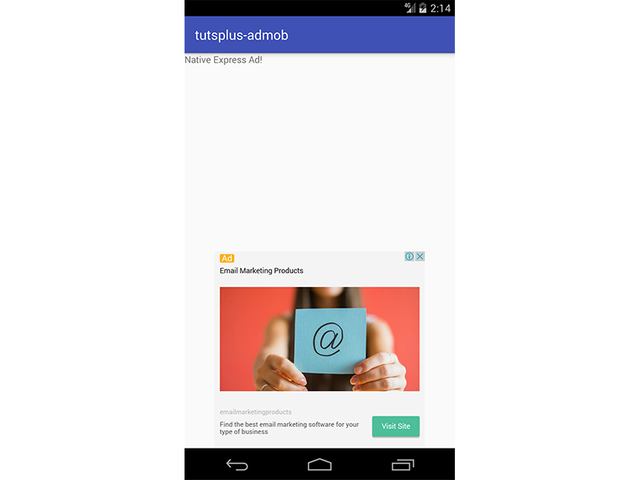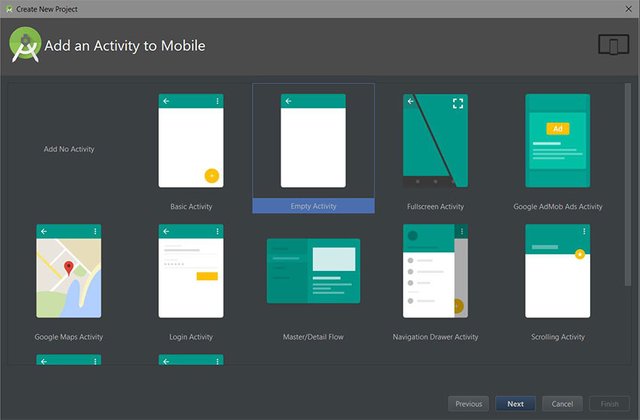Monetize Your Android Apps With AdMob
In this tutorial, you will learn how to adjust AdMob so that you can make money with this wonderful aerodynamic application, who does not want to? AdMob is one of the largest mobile advertising platforms on the market and it belongs to Google.
There are several different ways to monetize your apps in Android: pay for downloads, paid subscriptions, displaying purchases and ads in the app
You can add them, but you are recommended to select a template. In this tutorial, you'll learn how to monetize your app by showing ads.
The types of ads you create in this tutorial are banner, internal, and native express ads. I will explain to each of them and show how you want them to apply in your application. But first, let us first see how to integrate the Mobile Ads SDK and start getting it started. Create an Android Studio project
In Android Studio, create a new project called Main Achievement.
In this tutorial, you will learn how to adjust AdMob so that you can make money with this wonderful aerodynamic application, who does not want to? AdMob is one of the largest mobile advertising platforms on the market and it belongs to Google.
There are several different ways to monetize your apps in Android: pay for downloads, paid subscriptions, displaying purchases and ads in the app
You can add them, but you are recommended to select a template. In this tutorial, you'll learn how to monetize your app by showing ads.
The types of ads you create in this tutorial are banner, internal, and native express ads. I will explain to each of them and show how you want them to apply in your application. But first, let us first see how to integrate the Mobile Ads SDK and start getting it started. Create an Android Studio project
In Android Studio, create a new project called Main Achievement.
Add mobile ads SDK
To begin with integrating AdMob with your application, you must first include the ad SDK for your AP module version.
Compile 'com.google.android.gms: play-services-ads: 11.0.2'
If you want to add a FireBase file to your application, you must use SDK, which is part of the workbench:
Compile 'com.google.firebase: firebase-ads: 11.0.2'
Here is an overview of some of our Firebase tutorials on Anook Trojan + if you need help getting started with Firebase:
Make sure you sync the project after adding it the SDKs so as to pull the libraries from the internet into your application.
Initialize MobileAds
You need to initialize the Mobile Ads SDK before you can load ads on your Android app, so do this as early as possible. We create a class which extends the Application class, and then we initialize the MobileAds SDK in the onCreate() method of that class, because this method is called only once when the app is launched.
import com.google.android.gms.ads.MobileAds;
import android.app.Application;
public class App extends Application {
@OveRRide
public void onCreate() {
super.onCreate();
MobileAds.initialize(this, "ca-app-pub-3940256099942544/6300978111");
}
}
The second argument supplied to the static method initialize() of the MobileAds class should be your AdMob application ID you got when you signed up for AdMob. In this case, we are using the public application ID provided by Google for demo purposes.
Modify the Manifest File
We need to add the application class we created to the application tag name attribute in our AndroidManifest.xml file.
While in this file, also make sure to include the INTERNET permission so that Google mobile ads can run.
(html comment removed: Include required permissions for Google Mobile Ads to run. )
<uses-permission android:name="android.permission.INTERNET"/>
<uses-permission android:name="android.permission.ACCESS_NETWORK_STATE"/>
In the code snippet below, we added the AdActivity to our AndroidManifest.xml file within the application tag.
This activity is provided by the SDK. It is useful in banner ads to fire up the ad to be viewed when the user clicks on the ad, while for an interstitial ad, it is used for displaying the ad when the user clicks on it.
- Banner Ads
Banner ads cover a part of the currently visible screen. In other words, any content in your app and the ad are displayed together on the screen. This improves the user experience because your users can keep on using your app while the ad is showing, unlike an interstitial ad (just hang on, we'll get to that shortly). Note that a banner ad can be text or an image.
Let's look at how to implement a banner ad.
Include a Banner Ad in Your Layout
AdView is a custom ViewGroup that will contain the banner ad, so we need to edit our activity_banner_ad.xml layout file to include this view.
<com.google.android.gms.ads.AdView
android:id="@+id/adView"
android:layout_width="wrap_content"
android:layout_height="wrap_content"
android:layout_centerHorizontal="true"
android:layout_alignParentBottom="true"
ads:adSize="BANNER"
ads:adUnitId="ca-app-pub-3940256099942544/6300978111">
</com.google.android.gms.ads.AdView>
We are defining the AdView size by using the attribute ads:adSize and setting it to BANNER. Other alternatives available are LARGE_BANNER, FULL_BANNER, SMART_BANNER, etc.
The ads:adUnitId AdView attribute is set to a sample ad unit provided by Google. You'll have to update this with an ad unit associated with your account if you want to actually make money from your ads!
The ad unit ID identifies an ad placement, and you can find it in the AdMob admin console. This ID will tell AdMob the kind of ad to be displayed on your app and also the display format (image, text, or video).
Load the Ad
For us to finally show the ad, we need to make a request and then show it in the AdView we created above in the BannerAdActivity class.
import com.google.android.gms.ads.AdRequest;
import com.google.android.gms.ads.AdView;
import android.os.Bundle;
import android.support.v7.app.AppCompatActivity;
public class BannerAdActivity extends AppCompatActivity {
private AdView mAdView;
@OveRRide
protected void onCreate(Bundle savedInstanceState) {
super.onCreate(savedInstanceState);
setContentView(R.layout.activity_main);
mAdView = (AdView) findViewById(R.id.adView);
AdRequest adRequest = new AdRequest.Builder()
.addTestDevice(AdRequest.DEVICE_ID_EMULATOR)
.build();
mAdView.loadAd(adRequest);
}
}
We made an ad request by creating an instance of AdRequest using the builder. Then we used the method addTestDevice(), passing in a device id as an argument to receive test ads to the device, which in our case is the emulator. We then finally called the AdView method loadAd() that takes in this AdRequest instance and then loads the ad on a background thread (so as not to block the UI/main thread).
Test the Ad

From the screenshot above, we can see that our test banner ad is showing below the view. Now interact with the ad by clicking on it.
Listening for Ad Events With AdListener
Let's now explore the events or callbacks we can observe in an ad. These are the events available:
onAdLoaded(): this method is fired when the ad is retrieved.
onAdOpened(): this method is invoked when the ad is opened.
onAdClosed(): this method is fired when the ad is closed.
onAdLeftApplication(): this method is invoked when the user has left the application.
onAdFailedToLoad(int errorCode): this is fired when a request for the ad fails. The code can be one of ERROR_CODE_NETWORK_ERROR, ERROR_CODE_INVALID_REQUEST, ERROR_CODE_NO_FILL, or ERROR_CODE_INTERNAL_ERROR.
// ...
@OveRRide
protected void onCreate(Bundle savedInstanceState) {
// ...
mAdView.setAdListener(new AdListener() {
@OveRRide
public void onAdLoaded() {
super.onAdLoaded();
Toast.makeText(MainActivity.this, "onAdLoaded()", Toast.LENGTH_SHORT).show();
}
@OveRRide
public void onAdOpened() {
super.onAdOpened();
Toast.makeText(MainActivity.this, "onAdOpened()", Toast.LENGTH_SHORT).show();
}
@OveRRide
public void onAdClosed() {
super.onAdClosed();
Toast.makeText(MainActivity.this, "onAdClosed()", Toast.LENGTH_SHORT).show();
}
@OveRRide
public void onAdFailedToLoad(int i) {
super.onAdFailedToLoad(i);
Toast.makeText(MainActivity.this, "onAdFailedToLoad()", Toast.LENGTH_SHORT).show();
}
@OveRRide
public void onAdLeftApplication() {
super.onAdLeftApplication();
Toast.makeText(MainActivity.this, "onAdLeftApplication()", Toast.LENGTH_SHORT).show();
}
});
}
@OveRRide
public void onPause() {
// This method should be called in the parent Activity's onPause() method.
if (mAdView != null) {
mAdView.pause();
}
super.onPause();
}
@OveRRide
public void onResume() {
super.onResume();
// This method should be called in the parent Activity's onResume() method.
if (mAdView != null) {
mAdView.resume();
}
}
@OveRRide
public void onDestroy() {
// This method should be called in the parent Activity's onDestroy() method.
if (mAdView != null) {
mAdView.destroy();
}
super.onDestroy();
}
}
After adding the listener, run the project again and interact with the ad. Observe the events being invoked by watching the toasts we created.
- Interstitial Ads
We have seen how easy it is to display a banner ad. Now let's look at how to create interstitial ads.
Interstitial ads are ads that cover the whole screen of your application, giving no room for other views of your app to show (as we'll see shortly). Since this takes over the entire screen and also takes some time to load if the network is slow, you need to be careful not to irritate your users. So ideally these interstitial ads should be shown during natural breaks in your app, e.g. between levels in a game, and not when users are in the middle of some other task.
import com.google.android.gms.ads.AdListener;
import com.google.android.gms.ads.AdRequest;
import com.google.android.gms.ads.InterstitialAd;
import android.os.Bundle;
import android.support.v7.app.AppCompatActivity;
import android.widget.Toast;
public class InterstitialAdActivity extends AppCompatActivity {
private InterstitialAd mInterstitialAd;
@OveRRide
protected void onCreate(Bundle savedInstanceState) {
super.onCreate(savedInstanceState);
setContentView(R.layout.activity_main);
loadInterstitialAd();
}
private void loadInterstitialAd() {
mInterstitialAd = new InterstitialAd(this);
mInterstitialAd.setAdUnitId("ca-app-pub-3940256099942544/1033173712");
mInterstitialAd.setAdListener(new AdListener() {
@OveRRide
public void onAdLoaded() {
super.onAdLoaded();
Toast.makeText(MainActivity.this, "onAdLoaded()", Toast.LENGTH_SHORT).show();
if(mInterstitialAd.isLoaded()) {
mInterstitialAd.show();
}
}
@OveRRide
public void onAdFailedToLoad(int i) {
super.onAdFailedToLoad(i);
Toast.makeText(MainActivity.this, "onAdFailedToLoad()", Toast.LENGTH_SHORT).show();
}
});
AdRequest adRequest = new AdRequest.Builder().build();
mInterstitialAd.loadAd(adRequest);
}
}
In the code above, we declared and initialized an instance of the class InterstitialAd in the InterstitialAdActivity class. We set the add unit id by passing the Google-provided one as the only argument into the method setAdUnitId().
Just like what we did for the banner ad, we want to listen for events on the ad, so we set a listener to fire the overloaded methods onAdLoaded() and onAdFailedToLoad(int i). We make an ad request by creating an instance of the AdRequest class using its builder and then call the method loadAd(), passing this request as an argument to the method. We use the method isLoaded() to determine when the ad has been loaded and then call the method show() to finally display it.
You can also add an AdListener just like we did for the banner ad.
- Native Ads Express
Native Ads Express gives you (the publisher) the ability to customize the look and feel of ads so that they can fit naturally with your app. This customization is done by defining CSS templates in which you define your own fonts, colours, sizes, etc. from your AdMob account. You can't change the images, descriptions, and titles, though—these are set by the advertisers.
The customized ads can be displayed in your app in a NativeExpressAdView.
Include NativeExpressAdView in Your Layout
Below, we include the NativeExpressAdView, which is a ViewGroup, in our layout file. We also define the android:layout_height and android:layout_width to be wrap_content. The ads:adSize will be "320x300", and we'll use the Google-provided NativeExpress ad unit id (for demo purposes only).
<com.google.android.gms.ads.NativeExpressAdView
android:id="@+id/adView"
android:layout_width="wrap_content"
android:layout_height="wrap_content"
android:layout_centerHorizontal="true"
android:layout_alignParentBottom="true"
ads:adSize="320x300"
ads:adUnitId="ca-app-pub-3940256099942544/2177258514">
</com.google.android.gms.ads.NativeExpressAdView>
Load the Ad
Next, we build our AdRequest and then begin loading the ad to be displayed. We'll also add code to respond to the Activity lifecycle callbacks. You can also add an AdListener if you want, just like we did for the banner ad.
import com.google.android.gms.ads.AdRequest;
import com.google.android.gms.ads.NativeExpressAdView;
import android.os.Bundle;
import android.support.v7.app.AppCompatActivity;
public class NativeExpressAdActivity extends AppCompatActivity {
NativeExpressAdView mNativeExpressAdView;
@OveRRide
protected void onCreate(Bundle savedInstanceState) {
super.onCreate(savedInstanceState);
setContentView(R.layout.activity_native_ad);
mNativeExpressAdView = (NativeExpressAdView) findViewById(R.id.adView);
AdRequest.Builder adRequestBuilder = new AdRequest.Builder();
adRequestBuilder.addTestDevice(AdRequest.DEVICE_ID_EMULATOR);
mNativeExpressAdView.loadAd(adRequestBuilder.build());
}
@OveRRide
public void onResume() {
super.onResume();
mNativeExpressAdView.resume();
}
@OveRRide
public void onPause() {
mNativeExpressAdView.pause();
super.onPause();
}
@OveRRide
public void onDestroy() {
mNativeExpressAdView.destroy();
super.onDestroy();
}
}
Test the Ad


This post recieved an upvote from CHEF'S PLATE. If you would like to recieve upvotes from CHEF'S PLATE on all your posts, simply FOLLOW @tanishqsharma Please consider up-voting this comment as this project is supported only by your up-votes!
This post recieved an upvote from minnowpond. If you would like to recieve upvotes from minnowpond on all your posts, simply FOLLOW @minnowpond
This post has received a 1.50 % upvote from @buildawhale thanks to: @openbull. Send 0.100 or more SBD to @buildawhale with a post link in the memo field to bid on the next vote.
To support our curation initiative, please vote on my owner, @themarkymark, as a Steem Witness